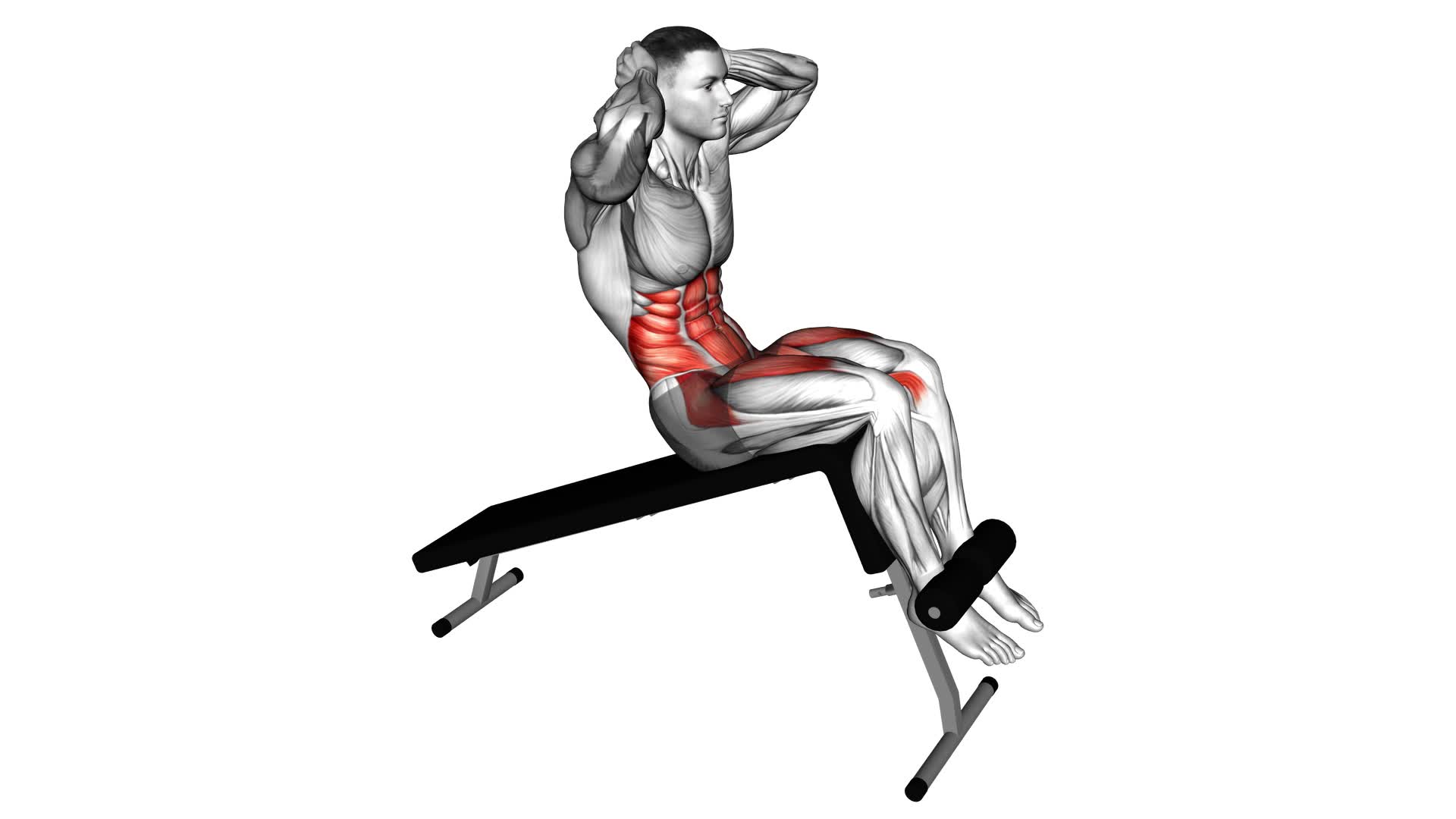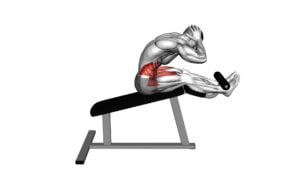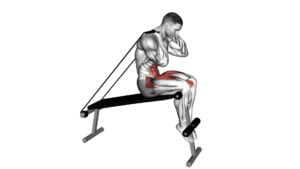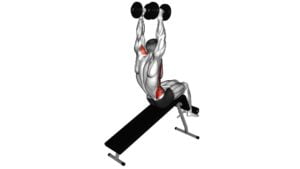Decline Sit-up – Video Exercise Guide & Tips

Are you looking to strengthen your core and build those abdominal muscles? Look no further than the decline sit-up! In this video exercise guide, we'll show you the proper form and technique to ensure you get the most out of this exercise.
Watch This Exercise Video
Whether you're a beginner or an advanced user, we've got modifications for everyone. Avoid common mistakes and maximize your results with our helpful tips.
Get ready to feel the burn and achieve your fitness goals!
Key Takeaways
- The decline sit-up targets the lower abs and engages multiple muscle groups.
- It increases resistance on the abs for greater muscle growth and creates a more balanced and defined midsection.
- Equipment needed includes a decline bench or adjustable bench set at a decline angle, stability ball or stack of pillows, sturdy and secure equipment, and a mat or towel for lower back cushioning.
- Alternatives to equipment include floor sit-ups, Russian twists, and effective bodyweight exercises.
Benefits of the Decline Sit-up
To maximize the effectiveness of your workout, incorporate the decline sit-up into your routine for a stronger core and improved abdominal muscle development. The decline sit-up is a highly beneficial exercise that targets your abdominal muscles and helps to build a stronger core. By performing this exercise on a decline bench, you increase the resistance on your abs, making them work harder and leading to greater muscle growth.
One of the main benefits of the decline sit-up is that it specifically targets your lower abs. Many traditional ab exercises primarily work the upper abs, but the decline sit-up focuses on the lower portion of your abdominal muscles, helping to create a more balanced and defined midsection.
Another benefit of the decline sit-up is that it engages more muscle groups than traditional sit-ups. As you lower your upper body towards the bench, you activate your hip flexors, which assist in the movement. This means that not only are you working your abs, but you're also engaging your hip flexors, creating a more well-rounded workout.
Additionally, the decline sit-up can be modified to suit your fitness level. If you're a beginner, you can start with a smaller decline angle or use assistance from a partner or resistance bands to make the exercise easier. On the other hand, if you're more advanced, you can increase the decline angle or hold a weight plate on your chest to make the exercise more challenging.
Incorporating the decline sit-up into your routine can offer numerous benefits, including stronger lower abs, improved core strength, and engagement of multiple muscle groups. Don't forget to modify the exercise to suit your fitness level and gradually increase the intensity as you progress.
Equipment Needed for the Exercise
Now, let's talk about the equipment you'll need for the decline sit-up exercise.
First and foremost, you'll need a decline bench or an adjustable bench that can be set to a decline position. This will provide the necessary incline for the exercise.
If you don't have access to a decline bench, you can use alternative equipment like a stability ball or even a stack of pillows to create a decline. However, it's important to ensure the stability and safety of these alternatives before attempting the exercise.
Safety should always be a priority, so make sure the equipment you use is sturdy and secure to prevent any accidents or injuries during the exercise.
Required Equipment for Exercise
You will need equipment for this exercise. The equipment options for the decline sit-up include a decline bench or an adjustable bench set at a decline angle. These benches are designed to provide support and stability during the exercise.
When choosing a bench, make sure it's sturdy and can safely accommodate your body weight. Additionally, you may need a mat or towel to provide cushioning for your lower back.
When it comes to space requirements, you should have enough room to fully extend your body on the bench and perform the sit-up motion without any obstructions. It's important to ensure that you have enough space to move comfortably and safely during the exercise.
Alternatives to Equipment
If you don't have access to the necessary equipment, you can still perform the decline sit-up using common household items. There are several no equipment exercises that can serve as effective bodyweight alternatives.
One option is the floor sit-up, where you lie on your back with your knees bent, feet flat on the floor, and perform a sit-up motion to engage your core muscles.
Another alternative is the Russian twist, which targets your oblique muscles. Sit on the floor with your knees bent, lean back slightly, and lift your feet off the ground. Twist your torso from side to side, touching the floor on each side.
These exercises can provide a challenging workout for your abs without the need for any additional equipment.
Safety Considerations for Equipment
Ensure proper equipment is used for the decline sit-up exercise to prioritize safety and effectiveness. Here are some safety considerations for the equipment needed:
- Equipment maintenance: Regularly inspect the decline bench for any signs of wear and tear. Check for loose bolts or unstable parts that may cause accidents during the exercise. Keep the equipment clean and free from any debris to prevent slips or falls.
- Proper warm-up techniques: Before starting the decline sit-up exercise, it's crucial to warm up your muscles to prevent injuries. Perform dynamic stretches and light cardio exercises to increase blood flow and prepare your body for the workout.
- Adjustable decline bench: Ensure that the decline bench is adjustable to different angles, allowing you to customize the intensity of the exercise. This feature allows you to target different areas of your abdominal muscles effectively.
- Secure foot holders: The decline bench should have secure foot holders to keep your feet in place during the exercise. This ensures stability and prevents any unnecessary strain on your lower back.
Proper Form and Technique
To perform the decline sit-up with proper form and technique, it's important to focus on body alignment, breathing techniques, and rhythm. Ensure that your body is aligned from head to toe, with your back straight and your core engaged throughout the movement.
Remember to breathe out as you come up and contract your abdominal muscles, and maintain a steady rhythm to maximize the effectiveness of the exercise.
Body Alignment During Sit-Ups
Consistently maintain proper body alignment during sit-ups to maximize effectiveness and prevent injury. Here are some tips to ensure you maintain the correct form:
- Position your feet flat on the ground, hip-width apart, with your knees bent.
- Engage your core muscles by pulling your belly button towards your spine.
- Keep your back straight throughout the exercise, avoiding any rounding or arching.
- Avoid pulling on your neck or using your arms to lift your upper body.
Maintaining proper body alignment during sit-ups is crucial for targeting your core muscles effectively and preventing strain on your neck and back. By following these guidelines, you can ensure that you're getting the most out of your sit-up routine while minimizing the risk of injury.
Breathing Techniques and Rhythm
Breathe rhythmically and maintain proper form to optimize your decline sit-up technique.
Proper breathing techniques can enhance your performance and help you maintain a steady rhythm throughout the exercise. As you lower your body back down, exhale slowly and fully, engaging your core muscles to control the movement.
Inhale deeply as you lift your upper body towards your knees, filling your lungs with air to provide stability and support. Remember to breathe consistently, avoiding shallow breaths or holding your breath, as this can disrupt your rhythm and decrease the effectiveness of the exercise.
Modifications for Beginners and Advanced Users
Make modifications to the decline sit-up to cater to both beginners and advanced users.
Whether you're just starting out or have been doing decline sit-ups for a while, these modifications will help you tailor the exercise to your fitness level and goals.
Here are some modifications you can try:
- Beginner modifications:
- Place your feet on the ground instead of the decline bench to reduce the difficulty and strain on your core.
- Use a smaller decline angle to decrease the intensity of the exercise.
- Start with a shorter range of motion, only lifting your upper body off the bench slightly until you build strength.
- Perform the exercise with your hands placed behind your head for added support.
- Advanced modifications:
- Increase the decline angle to challenge your core muscles even more.
- Hold a weight plate or dumbbell against your chest to add resistance and make the exercise more challenging.
- Perform the exercise with your arms extended overhead to engage your upper abs and obliques.
- Add a twist at the top of the movement to target your obliques and increase the difficulty.
By modifying the decline sit-up, you can adjust the exercise to match your fitness level and gradually progress over time.
Now let's move on to the next section and learn about common mistakes to avoid.
Common Mistakes to Avoid
To maximize the effectiveness of the decline sit-up, it's important to avoid common mistakes that can hinder your progress and potentially lead to injury. By ensuring you use proper technique, you can maximize the benefits of this exercise while minimizing the risk of harm.
One common mistake to avoid is using momentum to complete the movement. It's important to remember that the decline sit-up is meant to target your abdominal muscles, so using momentum takes away from the effectiveness of the exercise. Instead, focus on using your core muscles to lift your upper body.
Another mistake to steer clear of is placing your hands behind your head and pulling on your neck. This can strain your neck and lead to discomfort or injury. Instead, place your hands lightly behind your ears or cross them over your chest to support your head without pulling on your neck.
Lastly, avoid arching your lower back excessively during the movement. This can put unnecessary stress on your spine and lead to back pain. Keep your lower back pressed against the decline bench throughout the exercise to maintain proper spinal alignment.
Tips for Maximizing Your Results
Want to maximize your results with decline sit-ups? Follow these effective techniques to make the most out of your workout:
- Maintain proper form: Keep your back flat against the bench and engage your core muscles throughout the exercise. This will ensure that you're targeting your abdominal muscles effectively and minimizing the risk of injury.
- Increase resistance gradually: As you become stronger, challenge yourself by adding weights or resistance bands to increase the intensity of the exercise. This will help to build more muscle and improve your overall strength.
- Focus on the eccentric phase: Slowly lower your body back down to the starting position, focusing on the negative or eccentric phase of the movement. This will engage your muscles more and lead to greater muscle growth and definition.
- Include variety in your routine: Incorporate different variations of decline sit-ups, such as twisting or adding a medicine ball, to target different areas of your abs and prevent plateauing. This will keep your workouts challenging and ensure continued progress.
By incorporating these tips into your decline sit-up routine, you can maximize your results and achieve a stronger and more defined core.
Remember to always listen to your body and consult with a fitness professional if you have any concerns or questions.
Frequently Asked Questions
How Many Sets and Reps Should I Do for Decline Sit-Ups?
To get the most out of decline sit-ups, it's important to know how many sets and reps to do. Incorporating effective variations of decline sit-ups into your ab workout routine can yield great results.
Start by doing 3 sets of 10 reps and gradually increase as you get stronger. Remember, decline sit-ups target your lower abs and can help improve core strength.
Can I Do Decline Sit-Ups if I Have Lower Back Pain?
Yes, you can still do decline sit-ups if you have lower back pain. However, it's important to listen to your body and start with caution. Make sure to maintain proper form and engage your core muscles to support your lower back.
Gradually increase the intensity and number of repetitions as you feel comfortable. Remember, decline sit-ups can help strengthen your abdominal muscles and improve your overall core stability, which may provide some relief for lower back pain.
What Are Some Alternative Exercises That Target the Same Muscles as Decline Sit-Ups?
Looking for effective core exercises that target the same muscles as decline sit-ups? There are a few alternatives you can try.
Planks are a great option as they engage your core muscles and improve stability.
Russian twists also work your abs and obliques.
Another option is the hanging leg raise, which targets your lower abs.
Should I Do Decline Sit-Ups Before or After My Cardio Workout?
To get the most out of your workout, you might be wondering whether to do decline sit-ups before or after your cardio session.
It's generally recommended to do your cardio before your decline sit-ups. This is because cardio helps warm up your muscles and gets your heart rate up, which can prepare your body for the more intense decline sit-up exercise.
Combining cardio and decline sit-ups can provide numerous benefits, including increased calorie burn and improved overall fitness.
How Long Does It Take to See Results From Doing Decline Sit-Ups Regularly?
To see results from doing decline sit-ups regularly, it's important to be consistent and dedicated. Results can vary depending on factors like diet, genetics, and overall fitness level.
Generally, you may start noticing improvements in your core strength and definition within a few weeks. However, to see significant results in terms of muscle growth and increased endurance, it may take several months of consistent training.
The benefits of decline sit-ups include targeting your lower abs and hip flexors, improving stability, and enhancing overall core strength.
Conclusion
In conclusion, the decline sit-up is a highly effective exercise for strengthening your core muscles. By using the proper form and technique, you can maximize your results and avoid common mistakes.
Whether you're a beginner or an advanced user, there are modifications available to suit your fitness level. Remember to always use the necessary equipment and follow these tips to ensure you perform the exercise correctly.
Incorporate decline sit-ups into your fitness routine for a strong and toned core.

Author
Years ago, the spark of my life’s passion ignited in my mind the moment I stepped into the local gym for the first time. The inaugural bead of perspiration, the initial endeavor, the very first surge of endorphins, and a sense of pride that washed over me post-workout marked the beginning of my deep-seated interest in strength sports, fitness, and sports nutrition. This very curiosity blossomed rapidly into a profound fascination, propelling me to earn a Master’s degree in Physical Education from the Academy of Physical Education in Krakow, followed by a Sports Manager diploma from the Jagiellonian University. My journey of growth led me to gain more specialized qualifications, such as being a certified personal trainer with a focus on sports dietetics, a lifeguard, and an instructor for wellness and corrective gymnastics. Theoretical knowledge paired seamlessly with practical experience, reinforcing my belief that the transformation of individuals under my guidance was also a reflection of my personal growth. This belief holds true even today. Each day, I strive to push the boundaries and explore new realms. These realms gently elevate me to greater heights. The unique combination of passion for my field and the continuous quest for growth fuels my drive to break new ground.







